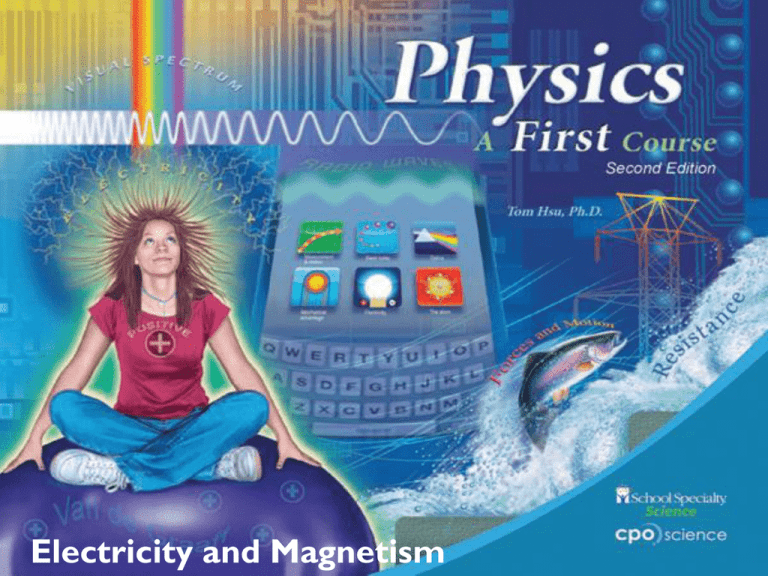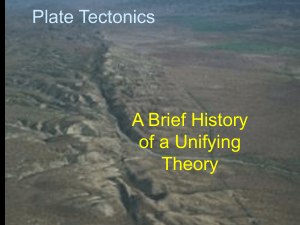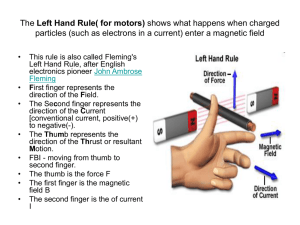Chapter 15: Magnetism
advertisement

Electricity and Magnetism Unit 5: Electricity and Magnetism Chapter 15: Magnetism 15.1 Properties of Magnets 15.2 The Source of Magnetism 15.3 Earth's Magnetic Field 15.1 Investigation: Magnetism Key Questions: How do magnets and compasses work? Objectives: Discuss the properties of permanent magnets. Measure magnetic force. Use a compass to detect magnetic force. Properties of magnets If a material is magnetic, it has the ability to exert forces on magnets or other magnetic materials nearby. A permanent magnet is a material that keeps its magnetic properties. Properties of Magnets All magnets have two opposite magnetic poles, called the north pole and south pole. If a magnet is cut in half, each half will have its own north and south poles. Properties of magnets Whether the two magnets attract or repel depends on which poles face each other. Magnetic force Magnetic forces can pass through many materials with no apparent decrease in strength. Magnetic force Magnetic forces are used in many applications because they are relatively easy to create and can be very strong. Large magnets, such as this electromagnet, create forces strong enough to lift a car or a moving train. The magnetic field All magnets create a magnetic field in the space around them, and the magnetic field creates forces on other magnets. The magnetic field The number of field lines in a certain area indicates the relative strength of the magnetic field in that area. The arrows on the field lines indicate the direction of the force. The closer the lines are together, the stronger the field. Magnetic field lines always point away from a magnet’s north pole and toward its south pole. Magnetic fields Magnets A and C feel a net attracting force toward the source magnet. Magnets B and D feel a twisting force, or torque, because one pole is repelled and the opposite pole is attracted with approximately the same strength. Magnetic fields The force from a magnet gets weaker as it gets farther away. Separating a pair of magnets by twice the distance reduces the force by 8 times or more. Magnetic fields You can actually see the pattern of the magnetic field lines by sprinkling magnetic iron filings on cardboard with a magnet underneath. Unit 5: Electricity and Magnetism Chapter 15: Magnetism 15.1 Properties of Magnets 15.2 The Source of Magnetism 15.3 Earth's Magnetic Field 15.2 Investigation: Electromagnets Key Questions: How are electricity and magnetism related? Objectives: Use a compass to detect magnetic force. Build a circuit to control an electromagnet. Measure the current used by an electromagnet. The Source of Magnetism Electromagnets are magnets that are created when there is electric current flowing in a wire. The simplest electromagnet uses a coil of wire wrapped around some iron. Right hand rule To find the north pole of an electromagnet, use the right hand rule. When the fingers of your right hand curl in the direction of the wire, your thumb points toward the magnet’s north pole. Electromagnets in toasters By changing the amount of current, you can easily change the strength of an electromagnet or even turn its magnetism on and off. Firedoors in hospitals and schools use electromagnets to release the heavy doors in emergencies. A toaster tray is pulled down by an electromagnet while bread is toasting. Building an electromagnet You can easily build an electromagnet from wire and a piece of iron, such as a nail. Wrap the wire in many turns around the nail and connect a battery. Building an electromagnet There are two ways to increase the current in a simple electromagnet: 1. Add more turns of wire around the nail. 2. Apply more voltage by adding a second battery. Why do these two techniques work? Doorbells Some doorbells contain an electromagnet. When the button of the bell is pushed, it sends current through the electromagnet and the striker hits the bell. Magnetism in materials All atoms have electrons, so you might think that all materials should be magnetic, but there is great variability in the magnetic properties of materials. The electrons in some atoms align to cancel out one another’s magnetic influence. While all materials show some kind of magnetic effect, the magnetism in most materials is too weak to detect without highly sensitive instruments. Magnetism in materials Atoms act like tiny magnets with north and south poles. When permanent magnets have their atoms aligned, we observe the magnetic forces. Magnetism in materials In many materials, the magnetic fields of individual electrons in each atom cancel each others magnetic effects. Lead and diamond are materials made of these kinds of atoms and are called diamagnetic. It takes either a very strong magnetic field to cause the effects or very sensitive instruments to detect them. Magnetism in materials Aluminum is paramagnetic. In an atom of aluminum, the magnetism of individual electrons do not cancel completely. This makes each aluminum atom a tiny magnet with a north and a south pole. Solid aluminum is “nonmagnetic” because the total magnetic field averages to zero. Nonmagnetic materials The atoms in nonmagnetic materials, like plastic, are not free to move or change their magnetic orientation. Ferromagnetic materials A small group of ferromagnetic metals have very strong magnetic properties. Examples of ferromagnetic materials are iron, nickel, and cobalt. Atoms in ferromagnetic materials align themselves with neighboring atoms in groups called magnetic domains. Magnetic properties of materials Magnetic domains in a ferromagnetic material will always orient themselves to attract a permanent magnet. — If a north pole approaches, domains grow by adding neighboring atoms that have south poles facing out. — If a south pole approaches, domains grow that have north poles facing out. Magnetism in solids Permanent magnetism only exists in solids. Permanent magnets and ferromagnetic materials become demagnetized if the temperature gets too hot. Even the best magnetic materials are only able to retain their magnetism only up to a few hundred degrees Celsius. Magnetism in solids If you use the north end of the magnet to pick up a nail, the nail becomes magnetized with its south pole toward the magnet. Because the nail itself becomes a magnet, it can be used to pick up other nails. If you separate that first nail from the bar magnet, the entire chain demagnetizes and falls apart. Unit 5: Electricity and Magnetism Chapter 15: Magnetism 15.1 Properties of Magnets 15.2 The Source of Magnetism 15.3 Earth's Magnetic Field 15.3 Investigation: Making a Model Maglev Train Key Questions: How can you make a model maglev train? Objectives: Use the Internet to conduct research about maglev trains. Apply the engineering cycle to design, build, and test a model maglev train. The Magnetic Field of the Earth As early as 500 B.C. people discovered that some naturally occurring materials— such as lodestone and magnetite—have magnetic properties. By 1200, explorers from Italy were using a compass to guide ocean voyages beyond the sight of land. Magnetite Magnetite, a magnetic mineral made of iron oxide, has been found in bacteria and in the brains of birds. Tiny crystals of magnetite may act like compasses and allow these organisms to sense the magnetic field of Earth. Earth as a magnet When you use a compass, the north-pointing end of the needle points toward a spot near (but not exactly at) the Earth’s geographic north pole. The Earth’s magnetic poles are defined by the planet’s magnetic field. That means the south magnetic pole of the planet is near the north geographic pole. Declination and “true north” Because Earth’s geographic north pole (true north) and magnetic south pole are not located at the exact same place, a compass will not point directly to the geographic north pole. The difference between the direction a compass points and the direction of true north is called magnetic declination. Magnetic declination and “true” north Depending on where you are, a compass will point slightly east or west of true north. The difference between the direction a compass points and the direction of true north is adjusted using a ring on the compass. After correcting for the declination, you rotate the whole compass until the north-pointing end of the needle lines up with zero degrees on the ring. The large arrow points in the direction you want to go. Maps and declination Maps often list the declination for an area. To go north, you must walk in a direction 16 degrees west of the direction the needle is pointing. The source of Earth’s magnetism The planet Earth has a magnetic field that comes from the core of the planet itself. The source of Earth’s magnetism Studies of earthquake waves reveal that the Earth’s core is made of hot, dense molten metals. Huge electric currents flowing in the molten iron produce the Earth’s magnetic field. The source of Earth’s magnetism The gauss is a unit used to measure the strength of a magnetic field. The magnetic field of Earth (.5 G) is weak compared to the field near the ceramic magnets you have in your classroom. (300- 1,000 G). For this reason you cannot trust a compass to point north if any other magnets are close by. Earth’s magnetic trend Today, Earth’s magnetic field is losing approximately 7% of its strength every 100 years. If this trend continues, the magnetic poles will reverse sometime in the next 2,000 years. Magnetism in stars and planets Like Earth, other planets in the solar system also have magnetic fields. In the case of Jupiter, the magnetic field is very strong compared to Earth’s and was mapped by the Cassini spacecraft. Magnetism in stars and planets Even stars have magnetic fields. The Sun’s uneven rotation twists its magnetic field lines. Every so often, the magnetic field lines become so twisted they “snap” and reconnect themselves. This sudden change causes huge solar storms where great eruptions of hot gas flare up from the Sun’s surface. Magnetic Resonance Imaging MRI is a powerful diagnostic technology. An MRI scanner makes a three-dimensional map of the inside of the body. As the name implies, MRI technology uses magnets and resonance to create images.







